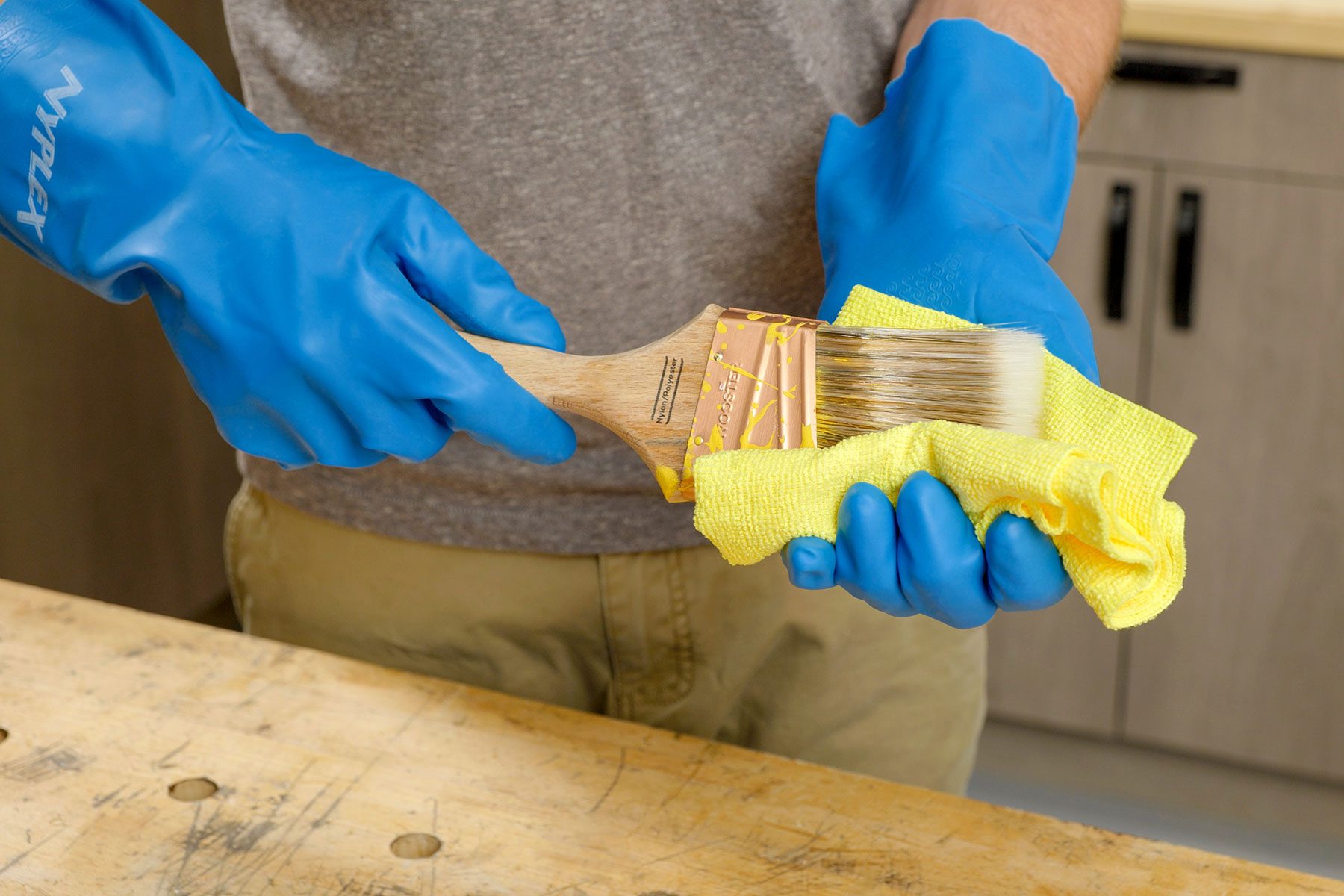Save money and your favorite brushes by learning how to clean paint from paint brushes, with techniques for every paint type and condition.
A few hours
Beginner
$20-50
Introduction
Good paint brushes are worth the money, whether you're painting with latex, oil or shellac. Here's how to clean paint brushes like a pro.
Cleaning my paintbrushes after a long day on a painting project is the last thing I feel like doing, and it’s so tempting just to toss them out! Whenever I lack the motivation to clean used paintbrushes properly, I remind myself of the cost of replacing them. Quality paintbrushes are designed to last a long time if you take care of them. You’ll know it’s time to toss out a paintbrush if the bristles are damaged or it has lost its original shape. But if your paintbrushes are in good condition apart from being covered in dried paint, you may be able to revive them with a few materials.
We’ll walk you through how to clean paintbrushes regardless of the paint or stain you use. The method for cleaning a paintbrush depends on the brush and the type of paint on it. A solvent-based cleaner is suitable for any brush (natural or synthetic), while a water-based cleaner is only good for synthetic brushes.
Some safety tips for cleaning paintbrushes are to always work in a well-ventilated area when cleaning brushes in solvents such as paint thinner, lacquer thinner, alcohol and ammonia. Never clean solvent-laden brushes around water heaters, stoves or any device with an open flame or potential electrical spark.
Most paintbrush manufacturers provide specific instructions for cleaning their brushes, so take that into account before you begin.
Tools Required
- Bucket
- Glass jar or empty paint can
- Paint brush comb
- Paint brush/roller spinner
- Paintbrush
- Rubber gloves
- Spring clamp
- Stiff bristle brush
Materials Required
- Denatured alcohol
- Dish soap
- Microfiber cloths
- Paint thinner
- Paper towels
Watch How To Clean Paint Brushes
Project step-by-step (9)
Cleaning Water-Based and Latex Paint From Brushes
Wash the brush in soapy water
- Put on gloves to prevent paint from getting on your hands.
- Fill a bucket with warm, soapy water and work the soapy water into the paintbrush bristles.
- Use a paintbrush comb to remove any dried clumps of paint or water-based varnish stuck in the brush. If you don’t have a paintbrush comb, using a sturdy plastic hair comb will also work.
- Once the stuck paint is removed, rewash the bristles in soapy water.

Spin the brush
- Spin the brush over a bucket or the sink with a paintbrush spinner for about 15 seconds.
- Blot the paintbrush dry on a clean microfiber cloth to remove the moisture in the paintbrush.
- Store it in a dust-free environment to keep it clean for future use.

Cleaning Oil-Based Paint From Brushes
Soak the brush in paint thinner
- Put on chemical-resistant gloves.
- Use a spring clamp to hang the paintbrush inside a glass jar.
- Fill the jar with paint thinner, only high enough to allow the bristles to be submerged. Let the brush soak for 5-10 minutes.

Clean the bristles
- Remove the paintbrush from the jar and gently comb the bristles downward. Avoid combing upward to prevent damage.
- After the solids have been removed, submerge the brush in a jar with clean paint thinner and mix it around for a few minutes, agitating the bristles.
- Spin the brush over a bucket or the sink with a paintbrush spinner for about 15 seconds.

Rinse with soapy water
- Fill a bucket up with warm, soapy water and work the soapy water into the bristles for a minute before rinsing it out with clean water.
- Spin the brush one last time to remove the water.
- Store it for future use.

How To Clean a Shellac Brush
- When you are done using a shellac-based finish, allow the brush to harden with the finish on it until you are ready to use it again for your next project.
- When you need the brush, let it soak in denatured alcohol for 20-25 minutes.
- Blot the excess alcohol from the brush with a clean shop towel. The bristles will be soft and ready for use.

How To Clean Dried Paint Brushes
Soak the bristles in paint thinner
- Put on chemical-resistant gloves.
- Hang the paintbrush inside a glass jar or clean paint can.
- Pour paint thinner into the jar and let the bristles submerge in the solution for 20-30 minutes.

Clean and rinse the bristles
- After soaking, start removing the paint from the paintbrush manually. Use a stiff, bristled brush to comb out the paint. Brush in a downward motion to avoid damaging the bristles. Clean both sides of the paintbrush until most of the paint has been removed.
- Rinse the brush in a jar with clean paint thinner in it and mix it around for a few minutes, agitating the bristles.
- Comb the bristles on both sides of the paintbrush with a paint comb to separate them.
- Rinse off the brush again, with soap and water this time.
- Spin the brush over a bucket or the sink with a paintbrush spinner for about 15 seconds.
- Blot dry and store it in a dust-free environment to keep it clean for future use.

FAQ
How do I get rid of paint thinner?
Don’t dump the mineral spirits or paint thinner when you’re finished. Let the paint solids settle to the bottom of the jar, and then pour the clear solvent into a fresh, clean container to save for next time. Let the solids dry outdoors and then dump them in the trash or at a hazardous waste collection location, depending on your municipality’s guidelines. Call your local trash service for proper disposal.
Should you wet a paintbrush before painting?
Yes, dampening the bristles before dipping the brush into paint can make it easier to clean.
How to soften a hard paintbrush?
Rinse the paintbrush under warm water while agitating the bristles. Another option is to heat distilled white vinegar, pour it into a glass jar, and let the brush soak in the vinegar for about 20 minutes.




















